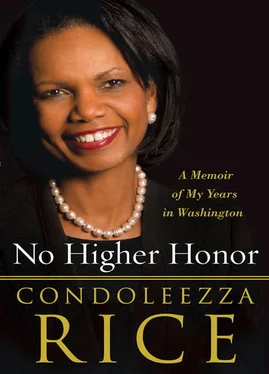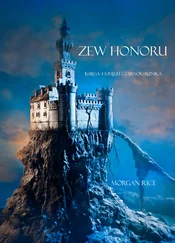When I arrived in Tripoli, I was asked to wait at one of the only Western-style hotels in the city. There was no doubt that the capital had once been a beautiful place, but it appeared run-down and tired. The only bright lights seemed to be those illuminating the many, many billboards of Qaddafi and his “inspirational” sayings. In speaking with Libyans, a distinct generational divide manifested itself. While the senior staff spoke English fluently and reminded me of my European colleagues, younger officials appeared to have had fewer educational opportunities and little contact with the West. It was another reminder of the sad consequences of Qaddafi’s monstrous rule.
After several hours, we were summoned to the residence, where I greeted the Libyan leader and sat down to hundreds of camera flashes. Qaddafi said a few completely appropriate words, as did I, and the press left. We began the conversation as Amado had suggested, talking about Africa in general and Sudan in particular. Libya, he promised, would help with alternative routes for humanitarian supplies to the refugees. This is going pretty well , I thought. He doesn’t seem crazy . Then, as Amado had predicted, he suddenly stopped speaking and began rolling his head back and forth. “Tell President Bush to stop talking about a two-state solution for Israel and Palestine!” he barked. “It should be one state! Israeltine!” Perhaps he didn’t like what I said next. In a sudden fit, he fired two translators in the room. Okay , I thought, this is Qaddafi .
It was Ramadan at the time of my visit, and after sundown the “Brother Leader” insisted that I join him for dinner in his private kitchen. Colby Cooper, who had overseen the arrangements for the trip, protested that this hadn’t been the plan. My security detail did as well, especially when they were told to stay outside. I thought I could take care of myself and went in. At the end of dinner, Qaddafi told me that he’d made a videotape for me. Uh oh , I thought, what is this going to be? It was a quite innocent collection of photos of me with world leaders—President Bush, Vladimir Putin, Hu Jintao, and so on—set to the music of a song called “Black Flower in the White House,” written for me by a Libyan composer. It was weird, but at least it wasn’t raunchy. The press was fascinated with my trip, and I sat down for an interview with CNN’s Zain Verjee (who often worked with producer Elise Labott on State Department coverage). Zain asked me about my personal impressions of Qaddafi. I remember that I came away from the visit realizing how much Qaddafi lives inside his own head, in a kind of alternate reality. As I watched events unfold in the spring and summer of 2011, I wondered if he even understood fully what was going on around him. And I was very, very glad that we had disarmed him of his most dangerous weapons of mass destruction. There in his bunker, making his last stand, I have no doubt he would have used them.

55
ONE LAST CHANCE FOR NORTH KOREA
THE NEGOTIATED END to Libya’s weapons of mass destruction program was evidence that rogue states could be convinced—with the right incentives—to give them up. Occasionally, President Bush would say, “Dictators don’t give up their weapons,” and then he’d immediately correct himself. “But Libya did,” he’d add in amazement. The prospect of a tyrant facing his last days with the ultimate weapon to protect himself is reason enough to seek an end to such programs. So too is the possibility of a dictator who, playing out an endgame scenario or perhaps in need of funds, detonates a nuclear bomb or sells the world’s most dangerous weapons to the highest bidder.
It was concerns such as those that made us accelerate efforts to end the North Korean nuclear program. Our negotiations with the North Koreans had been guided by three breakthrough documents. The first, the Joint Statement signed by the six parties in September 2005, had established the basic framework for an agreement on nuclear disarmament of the Korean peninsula. In it, the North had committed to abandoning its nuclear programs in exchange for the gradual granting of benefits (such as heavy fuel oil deliveries) and the eventual normalization of relations with the United States, Japan, and South Korea. As I have discussed previously, these benefits would be delivered only after verifiable progress had been made by the North toward declaring, disabling, and eventually dismantling its nuclear program.
In February 2007 and again in October 2007 the six parties signed two detailed implementation plans that laid out specific steps to meet the terms of the 2005 Joint Statement, including the shutdown of the nuclear reactor at Yongbyon, the resumption of inspections, and “a complete declaration of all nuclear programs” in North Korea. These were agreements Chris Hill, the assistant secretary for East Asian and Pacific affairs, had worked out with Kim Kye Gwan and then his Six-Party counterparts, and they required the United States to take a series of steps, including the return of the $25 million in frozen assets and the removal of North Korea from the U.S. list of state sponsors of terrorism, once the North Koreans had met their side of the bargain. The Chinese had played a major role in drafting the document.
The whole process had encountered a number of ups and downs, with diplomatic breakthroughs in 2005 followed by North Korean missile and nuclear tests in 2006. There was a surge of progress throughout much of 2007, followed by Pyongyang’s backsliding toward the end of the year, when the North failed to meet a year-end deadline for providing its nuclear declaration and disabling fully three of its Yongbyon nuclear facilities.
By 2008, though, the diplomacy had also produced some results. Even though Pyongyang had not completely disabled its known capability, the North had taken significant initial steps toward this goal, sealing and breaking down much of the infrastructure associated with Yongbyon. It had also readmitted weapons inspectors, including experts from the United States, who’d begun to “crawl all over” the nuclear site and verify its disablement. Rendering inoperable the North Koreans’ plutonium production capacity was a significant achievement, as we were worried that they might transfer the material to others.
We were focused at the beginning of the year on getting the North to submit its declaration. We expected Pyongyang to provide a full disclosure of all of its plutonium-related activities. Since the program’s existence was well known, the North Koreans seemed prepared to do this to a fairly acceptable level; we also had other sources of information in any case that could fill in any gaps.
But despite our successes on the plutonium side, serious concerns remained regarding our suspicions that the North Koreans had developed a second route to a nuclear weapon through uranium enrichment. It had been a problem since the earliest days of the administration, when we had received intelligence that the North had been pursuing a highly enriched uranium capability. The discovery had caused the postponement of Assistant Secretary Jim Kelly’s visit to Pyongyang in 2002. When the visit took place, the North Koreans seemed to admit that they had a program and then denied its existence. Confronted with the accusations, they responded by expelling weapons inspectors from the country in 2002 and withdrawing from the Nuclear Non-Proliferation Treaty the following year. We now needed the North Koreans to acknowledge their uranium enrichment capability in their declaration so that facilities and research associated with it would be covered by the inspection regime that we’d employ as a part of the agreement. This was no small matter; it was, in fact, the crux of the issue.
Читать дальше













